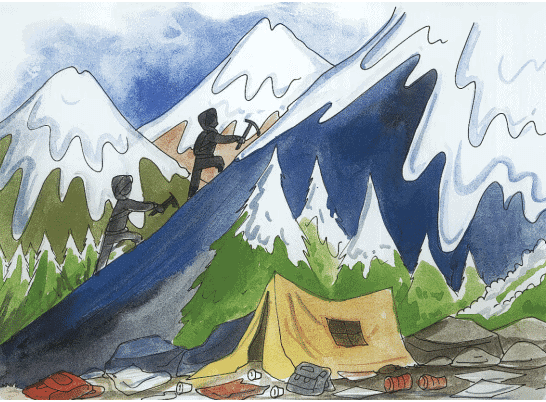Heroes of the Environment Chapter Notes | Communicative English for Class 10 PDF Download
| Table of contents |

|
| Key Points of the Story |

|
| Detailed Summary |

|
| Theme/ Message |

|
| Difficult Words |

|
Key Points of the Story
- The chapter discusses a significant cleanup expedition on Mount Everest, led by twenty brave Nepali climbers, including Namgyal Sherpa.
- These climbers are focused on cleaning a dangerous area known as the "death zone," which is located very high on the mountain.
- Namgyal Sherpa explains that cleaning in the death zone is challenging because of the thin air and extremely cold temperatures.
- Global warming has caused the snow on Everest to melt, revealing garbage that has been hidden for many years.
- Mount Everest is often called the world's highest garbage dump, as many climbers leave trash, including food containers, climbing gear, plastic, and even personal belongings.
- Barry G. Bishop, an American climber, referred to Everest as "the highest junkyard in the world" after his experience there.
- The team aims to remove at least 4,400 pounds of garbage during their cleanup mission.
- Since the first successful climb, over 4,000 climbers have reached the top of Mount Everest, which has contributed to the waste problem on the mountain.
- A specific effort will be made to recover the body of a Swiss climber who died on Everest in 2008.
- The climbers hope their actions will inspire future climbers to take better care of the mountain.
Detailed Summary
The team consists of twenty climbers, and they plan to tackle a very perilous area known as the "death zone." This zone is notorious for its extreme altitude, which results in thin air that makes breathing difficult. Additionally, the cold weather further complicates the climbing conditions. Namgyal Sherpa acknowledges the challenges of the cleanup mission, emphasizing that this is the first attempt to clear garbage from the death zone.

A primary motivation for this cleanup is the impact of global warming. As temperatures rise, snow that previously concealed much of the garbage is melting, revealing the trash beneath. This situation has prompted the Sherpas to act swiftly to collect the now-visible waste. Their objective is not only to clean the mountain but also to demonstrate that responsible stewardship of nature is possible.
Since the first successful ascent of Mount Everest, over 4,000 climbers have reached its summit, contributing to the growing amount of waste. Namgyal and his team aim to recover at least 4,400 pounds of trash during their expedition. In addition, they hope to honor the memory of a Swiss climber who passed away in 2008 by attempting to retrieve his body, providing closure for his family.
The mission transcends mere trash collection; it seeks to inspire future climbers to adopt a more responsible attitude toward the environment. The team believes that collective efforts to maintain the cleanliness of Mount Everest can preserve its beauty for future generations. By illustrating the importance of caring for the mountain, they hope to encourage climbers to reconsider their actions and minimize waste.
In conclusion, the cleanup initiative led by Namgyal Sherpa and his team is a vital step toward environmental conservation on Mount Everest. They are prepared to face the difficult conditions of the mountain to remove long-standing garbage. Their efforts aim to make Everest cleaner and serve as a model for others about the importance of respecting and protecting nature. This courageous mission holds great promise, and the world watches in hope for their success.
Theme/ Message
- The main theme of the chapter is environmental responsibility and the importance of taking care of nature.
- It shows how human activities, such as climbing Everest without proper care, can lead to pollution and damage to the environment.
- Another important message from the chapter is that everyone should work together to clean up and protect our planet.
- The climbers' mission illustrates that even in difficult situations, it is possible to make a positive change.
- By cleaning Mount Everest, the climbers want to set a good example for others and encourage them to respect nature.
Difficult Words
- Expedition - A journey undertaken for a specific purpose, especially for exploration or research.
- Climbers - People who climb mountains as a sport or adventure.
- Death Zone - An area on a mountain where the air is too thin for humans to survive for long.
- Global Warming - The gradual increase in the Earth's temperature due to human activities.
- Garbage - Waste or unwanted materials that are discarded.
- Pounds - A unit of weight; in this case, it refers to the amount of garbage to be removed.
- Environment - The natural world, including land, water, plants, and animals.
- Pollution - The introduction of harmful substances into the environment.
- Conquered - Successfully overcome or achieved something, like climbing a mountain.
- Inspire - To motivate or encourage someone to do something.
- Respect - To treat something with care and consideration.
- Climbing Gear - Equipment used by climbers to help them safely ascend mountains.
- Tins - Metal containers often used for storing food.
- Belongings - Personal items that belong to someone.
- Challenge - A difficult task or situation that requires effort to overcome.
|
8 videos|250 docs|8 tests
|
FAQs on Heroes of the Environment Chapter Notes - Communicative English for Class 10
| 1. What are the key points highlighted in the article "Heroes of the Environment"? |  |
| 2. Can you provide a detailed summary of "Heroes of the Environment"? |  |
| 3. What themes or messages are conveyed in the article? |  |
| 4. What are some difficult words found in "Heroes of the Environment" and their meanings? |  |
| 5. How can I prepare for an exam based on "Heroes of the Environment"? |  |














